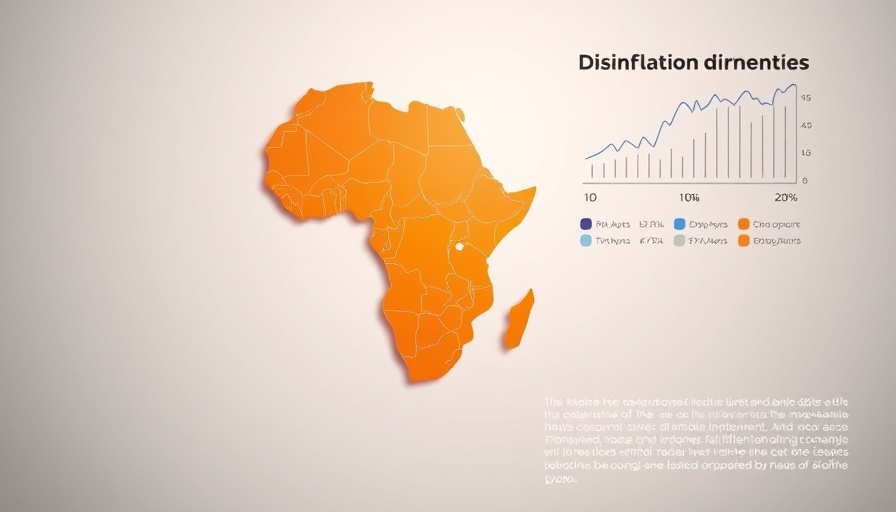
Emerging Disinflation Trends in Sub-Saharan Africa
Sub-Saharan Africa is witnessing significant shifts in economic conditions, particularly related to disinflation, a trend that is drawing the eyes of investors and market analysts alike. According to EBC Financial Group, Nigeria, Kenya, and South Africa are at the forefront of these trends, each presenting unique characteristics that shape the investment landscape.
Nigeria: Inflating Opportunities Amid Stability
In Nigeria, the latest data from the National Bureau of Statistics indicates that headline inflation has decreased for the third consecutive month, falling to 22.22% in June 2025. While still considerably higher than many regional peers, this subtle easing suggests that the Central Bank of Nigeria's (CBN) stringent monetary policies are yielding results. The benchmark lending rate has remained steadfast at 27.50%, which has helped maintain a level of stability for the Nigerian naira, recently trading around ₦1,518/USD. This active management reflects a broader trend in Sub-Saharan Africa where varying inflation rates are leading to differentiated fiscal strategies.
Kenya’s Transition to Easing: A New Era for Monetary Policy
Conversely, Kenya seems to be transitioning towards an easing monetary policy as it holds its inflation rate at a steady 3.8%. The Central Bank of Kenya (CBK) responded to sustained price stability by reducing its benchmark interest rate to 9.75%, the sixth consecutive cut this year. This strategic move not only enhances the attractiveness of local bonds but potentially strengthens the resilience of the Kenyan shilling, indicating a favorable environment for investors looking for opportunities in bond markets.
South Africa: Stability with Caution
Meanwhile, South Africa continues to maintain a relatively stable inflation rate of 2.8%. Despite its stability, the South African Reserve Bank (SARB) remains wary of potential global economic spillovers that could influence the local economy. Unlike Nigeria and Kenya, South Africa’s inflation is within the desired range, emphasizing a unique position among its neighbors. Understanding these distinct dynamics is crucial for investors who must navigate a landscape that is far from uniform.
Investing in Divergence: Strategies for Emerging Markets
As highlighted by EBC Financial Group's CEO, David Barrett, the current macroeconomic environment in Sub-Saharan Africa is ripe with opportunities stemming from these diverging trends. The critical takeaway for investors is the need for selective investment strategies rather than broad-based approaches. Those who grasp the differing inflationary pressures and central bank responses have the potential to capitalize on emerging markets, thus creating more tailored portfolios. Barrett emphasizes, "Africa is often viewed as a block, but markets here are increasingly differentiated—and understanding that distinction is essential for investors." This sentiment underscores the importance of dynamic risk assessment in light of varying economic indicators.
Global Economic Context and Its Local Repercussions
The ongoing global economic uncertainties also play a vital role in shaping policy decisions in Sub-Saharan Africa. As central banks globally adjust to inflationary pressures, regional authorities are forced to react differently based on their local economic conditions and growth targets. Investors must stay attuned to both local and international indicators to position themselves advantageously in this rapidly evolving marketplace.
Future Predictions: What Lies Ahead for Sub-Saharan Markets?
As disinflation takes root across Sub-Saharan Africa, the coming months will be critical for assessing how these economic indicators evolve. The strategic decisions made by central banks across these nations may not only affect local currency stability and bond yields but also signal broader trends in economic health and investment attractiveness. The careful balance between maintaining price stability and stimulating growth will be imperative for investors keeping a close eye on these key markets.
For investors and professionals tuned into the economic parameters of Sub-Saharan Africa, this moment presents a rare opportunity to engage with markets displaying distinct characteristics. With ongoing disinflation trends and central banks exhibiting differing degrees of responsiveness, the region calls for well-informed investment strategies that prioritize local insights and adaptive risk management.
 Add Row
Add Row  Add
Add 




Write A Comment